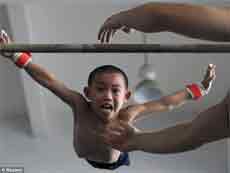Intense, Specialized Training in Young Athletes Linked to Serious Overuse Injuries
 Young athletes who specialize in one sport and train intensively have a significantly higher risk of stress fractures and other severe overuse injuries, even when compared with other injured athletes, according to the largest clinical study of its kind.
Young athletes who specialize in one sport and train intensively have a significantly higher risk of stress fractures and other severe overuse injuries, even when compared with other injured athletes, according to the largest clinical study of its kind.
For example, young athletes who spent more hours per week than their age playing one sport – such as a 12-year-old who plays tennis 13 or more hours a week – were 70 percent more likely to experience serious overuse injuries than other injuries.
Loyola University Medical Center sports medicine physician Dr. Neeru Jayanthi presented findings during an oral podium research session April 19 at the American Medical Society for Sports Medicine (AMSSM) meeting in San Diego. The study is titled “Risks of Specialized Training and Growth in Young Athletes: A Prospective Clinical Cohort Study.”
“We should be cautious about intense specialization in one sport before and during adolescence,” Jayanthi said. “Among the recommendations we can make, based on our findings, is that young athletes should not spend more hours per week in organized sports than their ages.”
Between 2010 and 20103, Jayanthi and colleagues at Loyola and Lurie Children’s Hospital of Chicago enrolled 1,206 athletes ages 8 to 18 between who had come in for sports physicals or treatment for injuries. Researchers are following each athlete for up to three years.
There were 859 total injuries, including 564 overuse injuries, in cases in which the clinical diagnosis was recorded. The overuse injuries included 139 serious injuries such as stress fractures in the back or limbs, elbow ligament injuries and osteochondral injuries (injuries to cartilage and underlying bone). Such serious injuries can force young athletes to the sidelines for one to six months or longer.
The study confirmed preliminary findings, reported earlier, that specializing in a single sport increases the risk of overall injury, even when controlling for an athlete’s age and hours per week of sports activity.
Among the study’s other findings:
•Young athletes were more likely to be injured if they spent more than twice as much time playing organized sports as they spent in unorganized free play — for example, playing 11 hours of organized soccer each week, and only 5 hours of free play such as pick-up games.
•Athletes who suffered serious injuries spent an average of 21 hours per week in total physical activity (organized sports, gym and unorganized free play), including 13 hours in organized sports. By comparison, athletes who were not injured, participated in less activity – 17.6 hours per week in total physical activity, including only 9.4 hours in organized sports.
•Injured athletes scored 3.3 on researchers’ six-point sports-specialization scale. Uninjured athletes scored 2.7 on the specialization scale. (On the sports specialization scale, an athlete is given one point for each of the following: Trains more than 75 percent of the time in one sport; trains to improve skill or misses time with friends; has quit other sports to focus on one sport; considers one sport more important than other sports; regularly travels out of state; trains more than eight months a year or competes more than six months per year.
Jayanthi offers the following tips to reduce the risk of injuries in young adults:
•Do not spend more hours per week than your age playing sports. (Younger children are developmentally immature and may be less able to tolerate physical stress.)
•Do not spend more than twice as much time playing organized sports as you spend in gym and unorganized play.
•Do not specialize in one sport before late adolescence.
•Do not play sports competitively year round. Take a break from competition for one-to-three months each year (not necessarily consecutively).
•Take at least one day off per week from training in sports.
Jayanthi and colleagues at Loyola and Lurie Children’s Hospital are planning a follow-up study to determine whether counseling recommendations on proper sports training can reduce the risk of overuse injuries in young athletes. The study is called TRACK – Training, Risk Assessment and Counseling in Kids.
“We will be testing our hypothesis that many of these serious injuries are potentially preventable,” Jayanthi said.
Source Newsroom: Loyola University Health System

